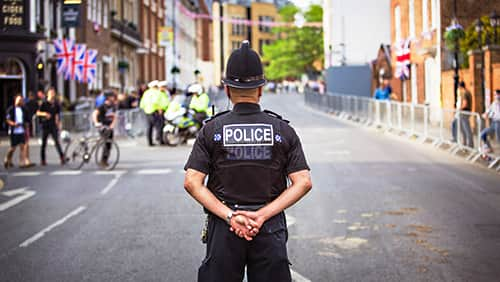London’s Police – An Overview
Law enforcement in the UK is a complex topic, one that cannot be summarised easily on one page. So, one of our Driver Guides, has used their knowledge to uncover the ‘need to know’ facts about our amazing police force. By the end of this blog, readers will be armed with a good overview of how London is policed.
The general structure of the British police force
Law enforcement in the UK is organised separately in each of its legal systems (i.e. England and Wales, Northern Ireland and Scotland). Most law enforcement is carried out by police officers serving in regional police services within one of those areas. The regional services are complemented by UK-wide agencies, such as the National Crime Agency and the national specialist units of certain territorial police forces, such as the Specialist Operations directorate of the Metropolitan Police. If you are a visitor to London, you will probably encounter officers of The Metropolitan Police Service (MPS) that we locals like to call: the ‘Met’ or ‘Scotland Yard’. The MPS is the territorial police force responsible for law enforcement in the Metropolitan Police District, which currently consists of the 32 London boroughs.
The Metropolitan Police
The Met are the UK’s largest police service and has 25% of the total police budget for England and Wales, with approximately 31,000 officers plus, over 10,000 police staff and police community support officers. They cover duties and specialities from street patrols (commonly known as ‘the beat’), dog handlers and river police to the mounted branch of police.
The mounted police branch is best known for maintaining order at unruly or violent demonstrations. But they have many other skills including controlling crowd movements to maximise safety at events, maintaining a physical presence and lighting up the faces of children and adults alike. The working life of a police horse and its officer is often misunderstood in fact, it takes a year to learn the specific skills needed to become a mounted police officer. It is predominantly the mounted police that you will see at the changing of the guard ceremony at St James Palace, Buckingham Palace and Wellington Barracks. Seeing the beauty of these well-trained horses – 3 quarters of a ton of muscle, bone and sinew, in real life, is an impressive sight!
Who founded the Metropolitan Police?
The Metropolitan Police were formed in 1829 under the instruction of founder Sir Robert Peel. Peel was known to be a colourful character with many talents. Aside from forming the first police force in the country, Peel lectured at Christchurch College in Oxford (one of the colleges that makes up the University of Oxford) and was even Prime Minister between 1841 and 1846. Londoners can still be heard referring to British police officers as “Bobbies” (a popular nickname for Robert) or “Peelers”, after the famous politician who created them.
The City of London Police
The Metropolitan police department policies a very large area but, it doesn’t cover the City of London also known as the “Square Mile”, where you will find St Paul’s Cathedral, the lovely Guildhall Gallery and St Bartholomew’s hospital, among other popular sites. The City of London Police are responsible for the ‘Square Mile’ and receive funding from the Corporation of London. They are a small but vital department.
The British model of policing
Police officers are granted certain powers to enable them to execute their duties. Their main duties are the protection of life and property, preservation of the peace, and prevention and detection of criminal offices. The British model of policing is unusual in that officers “police with the consent of the public” and are routinely unarmed. “Policing by consent” is one of the nine principles of policing that was laid down by Sir Robert Peel, it basically means that when a police officer asks a member of the public to do something, they will do it without question, respecting the authority of the officer (and not because the officer might kill them if they don’t). It is a model that has been adopted by many countries in the commonwealth (or former commonwealth countries) such as Australia, India, Canada, New Zealand, and adapted to their own national needs.
Sir Robert Peel’s nine principles of policing were developed to create an ethical British police force, and it is with these ideologies that the British people have been policed, predominantly by unarmed officers, enjoying freedoms unrivalled in any other country in the world. The best weapon a police officer has (in most instances) is their voice and the application of the law which the Magna Carta laid down foundations for on the 15th June 1215 at Runneymede, close to Windsor.
There are only a few police armed forces in Great Britain which are:
- The Police Service of Northern Ireland
- The Civil Nuclear Constabulary
- The Ministry of Defence
- The British Transport Police
Our Driver Guides hold a wealth knowledge on the comings and goings of our vibrant capital city, and they love nothing more than to chat to our guests about them. If you’d like to enquire with us for more information about our tours or pencil in a date for later in the year, please don’t hesitate to get in touch.






